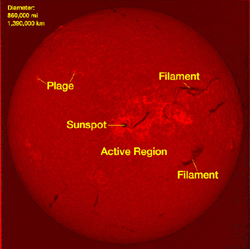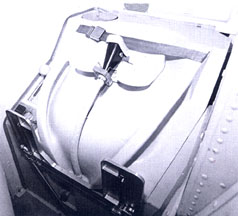Quickie Questions - Fun with the Sun - Interior/Surface
| Date Answered | Questioner (age, location) | Question | Answer |
|---|---|---|---|
| March 27, 2001 | Joyce (11, Canada) | What are the main areas of the Sun? | The main parts of the Sun (from the inside out) are the core, radiation zone, convection zone, the photosphere, chromosphere and corona. |
| June 15, 2000 | Kristen (age 12, Canada ) | What kind of star is the sun classified as? | The Sun is a yellow, main sequence star of class G2 V. |
| April 18, 2000 | Carrie (age 15, Illinois, USA) | At what rate [in watts] is energy produced by the sun? | The sun produces energy at the rate of 3.86e33 ergs/second or 386 billion billion megawatts. |
| July 8, 1999 | Ashley (age 11, Canada) | How many Earths could fit in the Sun? | Over 1.3 million Earths could fit inside of the Sun. The Sun actually contains about 99% of the mass in the solar system, so it makes sense. It still blows me away every time I think about it though. |
| May 25, 1999 | Yan (age 13, Texas, USA) | In our sun, the nuclei of hydrogen atoms combine to form helium atoms. Where do the electrons go? | The electrons are thrown out into space. They become part of the solar wind. |
| May 25, 1999 | Alejandra | I've collected several different data about pressure of the Sun's core and I don't know which is the correct. Could you help me? | The pressure inside the Sun is always different because we can't measure it! Scientists use equations to calculate the approximate value, but we can't measure it directly. In order to calculate the pressure, scientists need the temperature and the density, which are also approximated! Maybe some day we will have a consensus as to the true pressure. One of my favorite books gives a value of 3.4e11 atmospheres. |
| February 6, 1999 | Jodi (age 13, Indiana, USA) | What is fusion reaction? I'm doing a project on Star Trek, and the impulse engine is based on fusion reaction, so what is it? | This page will help. |
| January 5, 1999 | Alejandra (age 15) | Why do coronal mass ejections occur? What causes the Sun to eject a CME? In other words, how does it all start? | Coronal mass ejections are driven by the energy released from the Sun's magnetic field. You see, it is believed that the Sun's magnetic field gets twisted or bunched up. When it gets too twisted, sometimes it forces itself free. This releases energy that ejects material off of the Sun. This event is called a coronal mass ejection or a CME. |
| November 9, 1998 | Valen (age 9, Pennsylvania, USA) | How many Sun Spots are there? | The number of sunspots varies from year to year. You'll find that near a solar maximum, the number for that year will be over 100. During a solar minimum, you'll find under 15! In 1989, the last solar maximum, there were 158 sunspots. |
| October 7, 1998 | Brianne(Age 10, Pennsylvania, USA) | How bad are storms on the sun? | The study of how bad storms are on the Sun is called spaceweather. If a storm is really big, it can have quite an effect on the Earth! |
| August 28, 1998 | Stephanie (Age 15, California, USA) | Is is true that there are tornadoes on the Sun? Because it makes sense if they form clouds of gas because that's where tornadoes come from, clouds! | It seems there are tornadoes on the Sun--check this out! |
| May 8, 1998 | Abhinav (age 6, Thane, India) | On which side of the Sun are the sun spots? | Well, sunspots are found on all sides of the Sun. They move with the Sun as the Sun rotates. Very often, sunspots are found near the middle of the Sun (around the equator). Don't look directly at the Sun to see this though - it can hurt your eyes! |
| March 31, 1998 | Lauren (age 24, Virginia, USA) | Can you give a description of the surface of the Sun? | The photosphere looks somewhat boring at first glance: a disk with some dark spots. However, these sunspots are the site of strong magnetic fields. Also, if yo u look closely, you can see granulation on the surface of the Sun. This happens because of the tremendous heat coming from the solar core. The solar interior below the photosphere (the convection zone) bubble s like a pot of boiling water. The bubbles of hot material welling up from below are seen at the photosphere, as slightly brighter regions. Darker regions occur where cooler plasma is sinking to the interior. |
| December 2, 1997 | Kard (age 12) | How many elements are there? What is nuclear fusion? | There are currently 112 elements in the periodic table.
Nuclear fusion is the process in which 2 atomic nuclei combine to form a heavier element. This type of reaction releases huge amounts of energy. The most common fusion reaction occurs on the Sun in which hydrogen atoms fuse to form helium. If scientists can figure out a safe and efficient way to carry out fusion reactions Earth, this would provide us a sustainable and clean source of energy for hundreds of years to come. |
| November 26, 1997 | Christie (age 12, Louisiana, USA) | What is the Sun made of? | The Sun is about 75% Hydrogen and 25% Helium by mass. All of the other elements found in the Sun take up only .1% of the Sun's mass. |














